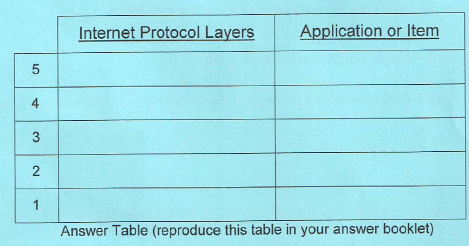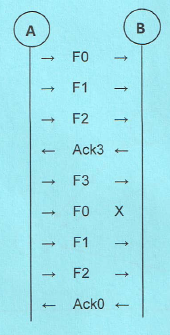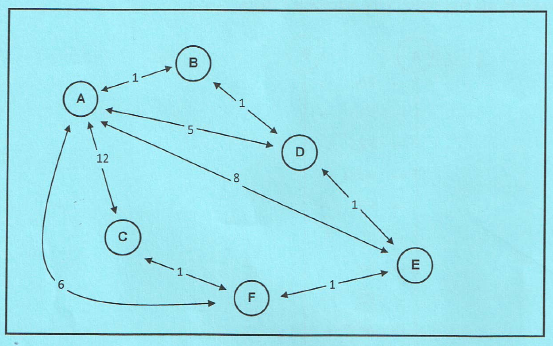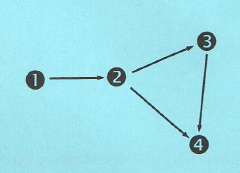Reference no: EM134976
Data Communications and Net-centric Computing Homework
LAN SECTION
Q1. List A below contains the layers of the internet protocol. List B contains items and applications associated with these layers. Recreate the answer table show below in your answer booklet and put the protocol layers in their correct order. In the next column. Put the application or item associated with that layer. User all the terms in your answer.
LIST A: network, data-link, application, physical, transport
LIST B: UDP, Cat-5 cable, Ethernet(IEEE 802.3), FTP(file transfer protocol), IP

Q2. In a Local Area Network you might encounter the following items of equipment.
State what layer each piece of equipment operates on and briefly describe its function/operation. (Point form answer are preferred)
- Firewalls
- Routers
- Repeaters
- Bridges (switches)
Q3. Name three well-known LAN topologies.
CSMA, CRC, Errors, Transmission System SECTION
Q4. Considering Media Access Control protocols:
a) What does CSMA/CA stand for?
b) Identify the differences between CSMA/CD and CSMA/CA
Q5. There are three type of persistence protocol used in CSMA.
a) State the name of one persistence protocol
b) State to rules use by the persistence protocol named in the previous question.
Q6. Calculate the Frame Check Sequences (FCS) for the following block of binary data, using the pattern (divisor) 10 11. Use any method. Show your working. Show the final code word that will be transmitted.
1 1 1 1 0 1 1
Q7. A new martian probe requires a communications system that supports a data rate of 12,000bps. The system selected uses FSK encoding with 8 levels.
a) How many bits are required to encode each level?
b) Assuming error free operation, calculate the bandwidth required for the system?
Q8. A communications link with a Bit error rate (BER) of 104 is used to send 1,250 byte packets of data.
a) Calculate the average number of transmissions required for the frame to be received without error.
b) To improve the efficiency of the line, it has been proposed to use Jumbo Packets of Size 12,500 bytes (10 times the current size). Do the same calculation for these larger packets.
c) Given the results of the last two calculations, comment on whether you support the Jumbo Packet proposal as a way to increase efficient use of the line and explain why.
IP, Windowing, Routing SECTION
Q9. You are given the IPv4 address 192.168.111.222 and subnet mask 255.255.224.0
a) What is the network-id?
b) What is the host-id?
c) Identify the following IP addresses as either suitable or unsuitable to be used as host addresses on the above subnet? Write the answer in your answer booklet.
IP Address:
i. 192.168.0.0
ii. 192..168.96.0
iii. 192.168.100.225
iv. 192.168.128.255
v. 192.168.96.222
Q10. A sliding window protocol using Go-Back-N and a window size of 4, is been used to send frames from station A to station B. The following frames have been sent, received and processed by the respective stations:

a) List the frame(s) now contained within A's sliding window.
b) Station A can be sure that some frames have been received by B. Which frames are they?
c) Which frame(s) will next be sent by A?
d) If the protocol is changed to Selective Reject, how would the efficiency change for normal error-free-operation?
Q11. Given the following network answer the question below:

Use an appropriate algorithm to identify the shortest path from A to all other nodes in the network. Show all working.
a) What is the shortest path from A to E. given the path as an ordered list of node numbers (list the nodes in the order that they occur in the path).
b) What is the path length of the shortest path from A to E.
c) What is the hop count of the shortest path from A to E.
UDP/TCP, BDP, FDM SECTION
Q12. Transport Control Protocol (TCP) and User Datagram Protocol (UDP) are both Transport Layer protocols. In what ways are TCP and UDP similar and how do they differ? Compare the feature, operation and applications. (Discussion or point form answers are acceptable.)
a) A 65 Mbps (64,000,000 bits per second) channel has propagation delay of 10mS from A to B and 20mS from B to A. What is the bandwidth-delay product between A and B? (10mS is 10 milliseconds or 10X 10-3 seconds.) Show your working.
b) If the link is going to be used to send 1000bytes packets, calculate the minimum window size required to achieve a line efficiency better than 0.8. Show your working

Q13. 4 analogue voice channels are FDM multiplexed together for transmission over a transmission system. Each channel has a bandwidth of 3 kHz. Guard bands of 400 Hz are used. The next available frequency slots starts at 20KHz.
a) Draw a frequency domain plot of the multiplexed signal.
b) What is the minimum bandwidth required to transmit the multiplexed signal?
ATM, Timing, Compression SECTION
Q14. 4,800 bytes of payload are transmitted over ATM between two stations.
a) How many cells will be required?
b) What percentage of the resulting data stream is overhead?
c) How would the percentage overhead change if only 2400 bytes was transmitted?
Q15. This question relates to the simple network shown below. In this network, packets sent from Node 1 are received at Node 2 and then forwarded on to the next node. From the moment a packet arrives at Node 2, it experiences a sequence of delays before arriving at the next node. Assume the network suffers some congestion.
a) List all four delays each packet will encounter.
b) Which of these delays is most sensitive to congestion?

Q16. A video-conferencing application is expected to transmit images of 720 X 576 pixel, at 10 frames per second. Pixels are in RGB colour, encoded using 3 bytes per pixel. The application will use a lossy compression algorithm which gives 8:1 compression.
a) Calculate the amount of data (in bytes) required for each uncompressed image.
b) Calculate the amount of data (in bytes) required for each compressed image.
c) Calculate the rate at which compressed video data must be transmitted (in bits per second).
d) The total network overhead (transport, network and data-link layers) is 18% of the application payload. Calculate the channel capacity required to send the video (in bits per second).